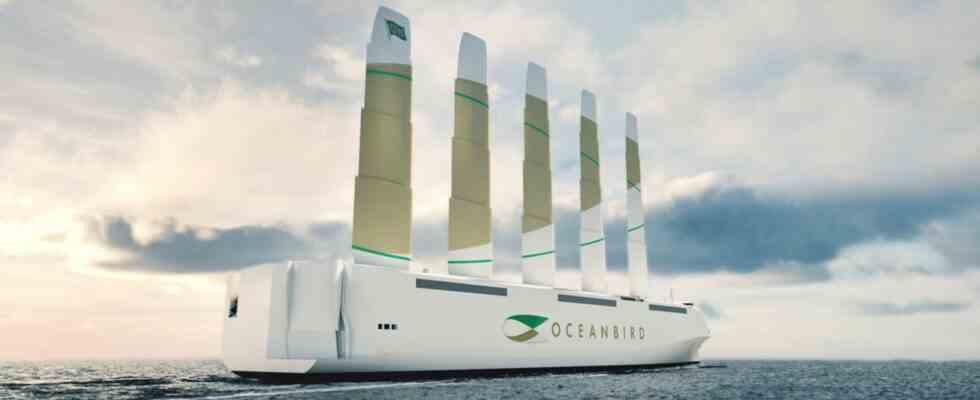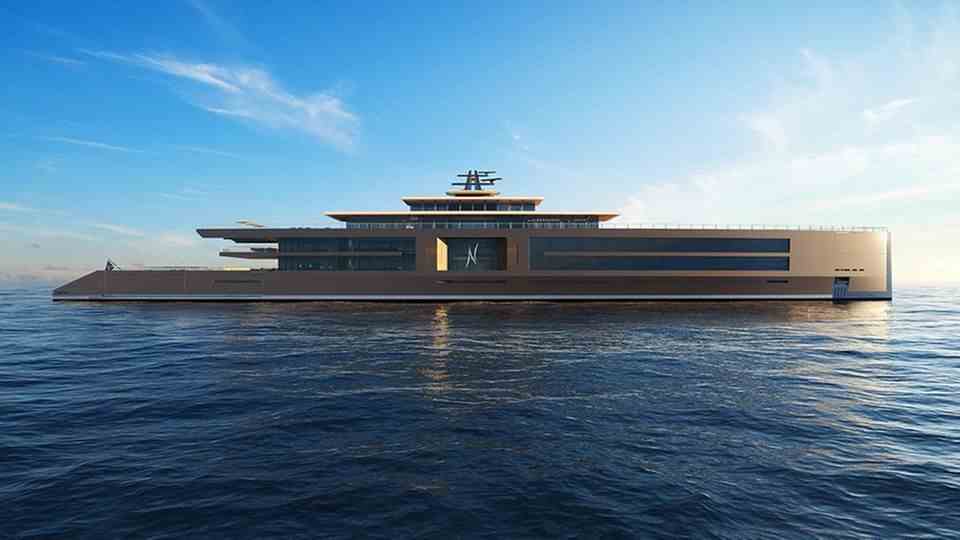ship technology
Oceanbird – this is what the renaissance of environmentally friendly sailing ships could look like
The ship was developed as a RoRo ship for car transport.
© Wallenius
Merchant ships pollute the atmosphere with their cheap and dirty heavy fuel oil. The Swedish “Oceanbird” is to cross the Atlantic using only wind power, thereby reducing emissions by 90 percent.
For more than 6000 years, people have used sailing ships to cross lakes, rivers and seas with little effort. The oil age put an end to this tradition. Even before the Second World War, sailing ships had largely disappeared from commercial shipping and survived as leisure vehicles.
Oil never got expensive enough
Since the oil crisis of the 1970s there have been repeated attempts to stimulate commercial sailing. The calculus behind it was based on the fact that wind is cheaper than oil. And with rising oil prices, sailing ships would have to be profitable, even if they were more complex to build and slower to drive. The predicted, fabulous increases in oil prices never came about, the sailing ships – even experiments with kites – remained experiments.
The Swedish shipyard Wallenius Marine is making a new attempt, not with a test boat, but with a 200 meter cargo ship for the commercial market. The “Oceanbird” is a joint project of the shipbuilder Wallenius Marine, the Swedish research institute SSPA and the Royal Institute of Technology in Stockholm. The ship is scheduled to be launched in 2024 and would then be the largest sailing ship in the world at 200 meters long and 40 meters wide.
90 percent fewer emissions
The “Oceanbird” is not primarily focused on cost savings, the main argument in favor of the sailing freighter is the significantly lower consumption of resources and the 90 percent lower emissions of climate-damaging CO2. In recent years, the emissions from cruise ships have been viewed very critically – the contribution that freighters and container ships are responsible for has received far less attention.
The “Oceanbird” now promises to reduce emissions from cargo shipping by up to 90 percent with its five huge 80-meter-long retractable wing sails. It is a gigantic car and truck transporter and can hold up to 7000 cars. The average speed on the North Atlantic route is estimated at 10 knots. This is noticeably slower than a conventional ship. The crossing will take 12 days instead of the usual eight. The slower speed is the main handicap of all sailing ships. Seen over the year, they only manage two thirds of the routes of oil-powered ships – the amortization of the capital investment is correspondingly poorer. Added to this are the higher labor costs per trip.
Not a model for container ships
The wing sails are made of metal and composite materials. These are sails of a completely new type. Unlike yachts, the sail area is not pulled into the mast and rolled up there. It is not a classic sail at all, the sails of the “Oceanbird” resemble the wing of an airplane. They are therefore not gathered. They are raised or lowered like a telescopic rod. So they can disappear in the hull. This is to stabilize the ship in a storm and only in this way can it pass under bridges. Naval architect Carl-Johan Söder says the design features a unique combination where the hull and mast work together as one. The entire ship is optimized for cruising the world’s oceans. In addition to the sails, the “Oceanbird” has auxiliary engines that allow the ship to maneuver better and that can step in in emergencies.
A seven meter model has already been tested in calm water. In the next few months it will be tested on the open sea. The planning should be completed by the end of 2021. Wallenius wants to deliver the first ship at the end of 2024. The planners assume that the technology of the “Oceanbird” can be used in many large ship types – including crusaders. They are only skeptical about container ships because these ships need the entire surface to load the containers.
Tax-free climate impact
Commercial shipping contributes around 2.5 percent to global CO2 emissions. However, it is responsible for 18 to 30 percent of the nitrogen oxides that get into the atmosphere and for 9 percent of the sulfur oxides. The mismatch arises because the ships can burn dirty heavy fuel oil.
In order for ships like the “Oceanbird” to be able to assert themselves, more than just a change in awareness among the population will probably have to happen. As long as ships on the high seas do not pay any taxes for their fuel and do not have to obey any requirements for environmentally friendly propulsion, climate-friendly sailing ships will have a hard time vis-à-vis the dirt competition. However, if international merchant shipping has to pay environmental taxes and can no longer pollute the atmosphere for nothing, the relationship will be reversed. Because the wind could continue to be used tax-free.
source: oceanbird
Also read:
“Nature” This super yacht combines luxury with nature
After superyachts, are luxury submarines for the super-rich coming?
Mini submarine – the “Nemo” would make James Bond jealous
This air-to-water taxi is based on the design of Hitler’s rocket builders




